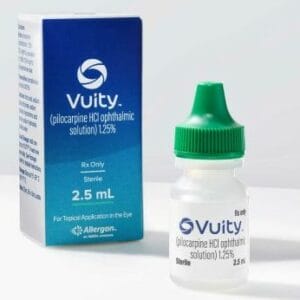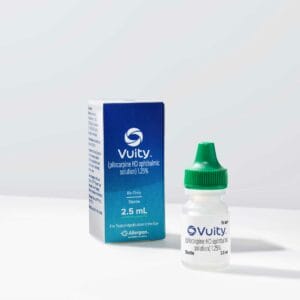September 1, 2023
It is the largest unmet market of all time. A condition that affects nearly 100% of all human beings. A scourge that maddens mankind to no end. Oceans are probably littered with billions of old washed-up pairs of reading glasses. Most people don’t even think about their eyes until presbyopia hits, and yet so many struggle for years without seeking an eye care provider’s opinion. It’s the talk of the town at lunches, dinners, and happy hours. By now as an ECP, you’ve seen it all. You may be tired of talking to your patients about what presbyopia is, why they “have it,” and the not-so-compelling solutions we currently have to offer.
Options for Presbyopes
Let’s consider where we’ve been and where we’re headed in this battle against presbyopia. Start with glasses. We have readers, with all their inherent downsides, as our main battle sword of self-treatment. Then we move to the professional channel where patients ask us for something more, something that will ease the burden of readers. We then get to move into the enchanted discussion of progressives or lined bifocals, certainly not what most near emmetropic patients are clamoring for as a solution to their problem.
The next logical option is contact lenses, where we delve into the complicated patient perspective on monovision and multifocal contact lenses. Throw in hybrid lenses, GP multifocals, and sclerals, and it doesn’t take much to get patients a little skeptical that this might be all worth it. And I hate to admit it, but our ECP success rate is low, and many won’t even consider fitting an advanced design presbyopia lens.
Finally, in the surgical realm we have witnessed many noble attempts, but most have failed, and the best modality (multifocal IOLs) have never seen a market share over 10-15% of all lens replacement surgeries. While I won’t name all the surgical attempts, let me give you a few to remind you and frame our reference regarding the efficacy of procedures to date: Holmium LTK, iris claw lenses, piggyback lenses, scleral expansion bands, corneal pinhole inlays, Crystalens, and all the current day multifocal/extended depth of focus IOLs.
First-of-its-kind Presbyopia Treatment Approved
After years of conceptualization based on the enhanced depth-of-focus and depth-of-field effects of miotics, Allergan commercialized the first presbyopia drug with Vuity in 2021. The pharmacological moiety is pilocarpine 1.25%. The original FDA approval was for the 1.25% once daily. Subsequently, Allergan submitted data to achieve BID dosing to allow for more flexibility in the dosing. It is interesting to note that the therapeutic concentration used in glaucoma practice is between 1% and 4% with at least BID if not QID dosing. It is derived from an alkaloid from the leaves of tropical South American shrubs from the genus Pilocarpus.
Pharmacologically, pilocarpine is a miotic with a long track history of utilization in glaucoma. In fact, prior to Thom Zimmerman’s work to develop timolol, pilocarpine was the most utilized agent for glaucoma until the early 1980s. While we are talking about pilocarpine, let’s look at how the drug works as a miotic in glaucoma and its mechanism of action. Pilocarpine increases trabecular outflow by binding to and activating muscarinic (M3) receptors on the smooth muscle fibers in the ciliary body, leading to contraction of the ciliary muscle/body. This also results in miosis because of the effect on the iris sphincter resulting in the increased depth of focus. There have been questions about whether these low concentrations of pilocarpine are also eliciting an accommodative effect in addition to the miotic effect. This might help explain some of the benefit of a miotic in presbyopia. This is a complicated area, dissociating the accommodative response from the miotic response is virtually impossible. It is very likely that there are muscarinic subtypes involved in this dissociation between responses. It is further complicated by variations in the studies as species vary (monkey vs. rabbit etc.) and in vitro vs. in vivo work.1,2,3,4
Vuity was approved by the FDA nearly three months earlier than the published PDUFA date, and I think it caught eye care giant Allergan by surprise. While there was a planned realignment of the sales force to promote Vuity, I don’t think it was ready to go when the drug was approved ahead of schedule. The same could be said for the marketing, targeting and direct-to-consumer pieces that surely would play a part in the success of the launch. Basic launch queries such as, “Who will this work best with?” or “How do I identify the best candidates; are they emmetropic, myopic, hyperopic, old or younger, presbyopes, part-time users?” didn’t exist. Mix in the throes of the COVID-19 pandemic, and you can see how things got off track quickly for Allergan and Vuity.
CSF-1 Versus Vuity
Adding insult to injury, side effects and adverse events that were not identified in the two Phase 3 clinical trials began to emerge. Some were serious such as retinal detachments, macular holes, and other vitreomacular phenomenon. Others were more salient but equally distracting, such as headache, dimming of the vision, reduced distance acuity, and disorientation. These adverse events were common if the doctor didn’t educate and warn of their likelihood.
But this is a category that needs to be successful, it must be triumphant if we are trying to solve one of the biggest unmet needs in all health care. To that end, the next most likely drug candidate to see approval by the FDA is Orasis’s CSF-1. With a PDUFA date in October of 2023, this drug represents the next shot on goal in the pharmacological battle against presbyopia. Let’s look at how it’s different from Vuity, and how it has a chance to relaunch the category.
Let’s talk about pilocarpine. For starters, CSF-1 is a fraction of the pilocarpine concentration of Vuity, 0.4% vs. 1.25%, respectively. Given the mechanism of action of pilocarpine, ultimately the pupil size determines the increase in depth of field and depth of focus. For its FDA submission, Orasis sponsored NEAR-1 and NEAR-2 with more than 600 patients total between the two studies. The PDUFA date has been announced to be Oct. 22, 2023. The NEAR-1 and NEAR-2 studies were both two-week parallel-group studies of CSF-1 (0.4% pilocarpine HCL) vs. vehicle. The primary endpoint in both NEAR trials was the proportion of patients achieving a 3-line or greater improvement compared to baseline in mesopic distance corrected near visual acuity (DCNVA) without loss of 1-line or greater corrected distance visual acuity (CDVA). In addition, there was a post hoc analysis to identify the percentage of patients who achieve 20/40 or better DCNVA. After screening and enrollment, patients were randomized to CSF-1 or vehicle. Patients were assessed after bid dosing at days 1, 8, and 15. Results demonstrated that most patients showed a sustained 2-line improvement in DCNVA for up to eight hours post dosing. At the end of the study, the percentage of patients achieving a 2-line or greater improvement in DCNVA (and also did not lose 1-line or more of CDVA) was 61.4% for CSF-1 versus 43.3% of those receiving placebo (p<0.0001). This is equivalent to approximately 20/40 or better Snellen functional near acuity.
Questions About Side Effects Remain
As you can see, CSF-1 could have at least the equal therapeutic presbyopic effect as Vuity if you consider lines of near acuity gained and pupil size reduction. It’s difficult to predict the side effects of novel treatments such as pilocarpine. Certainly, no vitreomacular events were observed, no dimming of vision, no loss of distance visual acuity, with 100s of patients. But sure enough, all those things happened with Vuity when it hit the market. It begs the question, will CSF-1’s over 50% reduction in concentration help the side effect situation relative to Vuity? Intuitively, it should but we will have to get experience to know for sure. If there is improvement in the side effect profile and we get the same efficacy as with Vuity, I think there is a chance to relaunch the category. A failure to launch is just not tenable if we are going to turn the tide on presbyopia pharmacologically.
References
1 Schroeder A et al. Cholineric agnosists do not increase trabecular outflow facility in the human eye. Invest Ophthalmol Vis Sci 1994; 34 (sup): 2054.
2 Kaufman, P et al. Chonicergic mechanisms and aqueous humor dynamics. In: Drance SM et al editors Pharmacology of Glaucoma. Williams and Walk-ins; 1992 64-92.
3 Fechner PU et al. Accommodative effects of acedlidine in the treatment of glaucoma. Am J Ophthalmol 1975; 79:104-106.
4 Poyer JF et al. The effect of muscarinic agonists and selective receptor subtype antagonists on the contractile response of the isolated rhesus monkey ciliary muscle. Exp Eye Res 1994; 59: 729-736.
Getty Images





